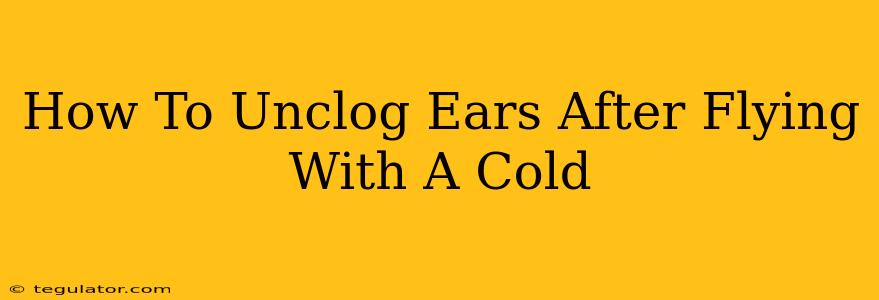Flying with a cold can be a miserable experience, especially when it leads to painfully clogged ears. The pressure changes during takeoff and landing, combined with the already congested nasal passages from your cold, can create significant discomfort. But don't worry, there are several safe and effective ways to unclog your ears after flying while battling a cold. This guide will walk you through the best methods, helping you find relief and get back to enjoying your trip (or just feeling comfortable at home!).
Understanding Why Your Ears Clog During Flights
Before we dive into solutions, it's helpful to understand the cause. During air travel, the change in cabin pressure affects the air pressure in your middle ear. Normally, your Eustachian tubes—the tiny canals connecting your middle ear to the back of your throat—equalize this pressure. However, when you have a cold, these tubes can become inflamed and swollen, hindering their ability to open and close properly. This pressure imbalance causes the feeling of fullness or pain in your ears.
Safe and Effective Ways to Unclog Your Ears
Here are several techniques you can try to relieve ear pressure after flying with a cold:
1. The Valsalva Maneuver: A Gentle Approach
This classic method involves gently attempting to equalize the pressure yourself. Caution: Avoid forceful attempts, as this can be harmful.
- How to do it: Pinch your nostrils closed, close your mouth, and gently blow air out through your nose as if you were trying to blow your nose. You should feel a slight "pop" in your ears as the pressure equalizes. Repeat as needed, but stop immediately if you feel any pain.
2. The Toynbee Maneuver: An Alternative Approach
Similar to the Valsalva maneuver, this technique uses swallowing to help open the Eustachian tubes.
- How to do it: Pinch your nostrils closed, swallow repeatedly, and gently try to open your mouth and keep it in a yawning position. This motion might help open your Eustachian tubes.
3. Yawning: A Natural Pressure Equalizer
Sometimes, simply yawning can do the trick. Try to yawn naturally or stimulate a yawn by opening your mouth wide and holding it for a few seconds.
4. Over-the-Counter (OTC) Medications: Temporary Relief
For more significant congestion, over-the-counter decongestants (like pseudoephedrine or phenylephrine) can help reduce swelling in your nasal passages and Eustachian tubes. Always follow the dosage instructions carefully and consult your doctor or pharmacist if you have any concerns or pre-existing conditions.
5. Saline Nasal Spray or Rinse: Clearing the Airways
A saline nasal spray or rinse can help moisten and clear nasal passages, making it easier for the Eustachian tubes to function properly. This can be especially helpful before and after your flight.
Preventing Clogged Ears During Future Flights
Prevention is key. Here are some tips to minimize the risk of ear pressure issues on your next flight:
- Stay Hydrated: Drink plenty of fluids before, during, and after your flight to keep your nasal passages moist.
- Avoid Alcohol and Caffeine: These can dehydrate you, making congestion worse.
- Chew Gum or Suck on Candy: The swallowing motion can help equalize pressure.
- Use Nasal Strips: These can help open your nasal passages.
- Consider Decongestants (with doctor approval): If you frequently experience ear pressure during flights, talk to your doctor about using decongestants before and after your flights.
When to See a Doctor
While most ear pressure issues resolve on their own, seek medical attention if:
- The pain is severe or persistent.
- You experience hearing loss.
- You have a fever or other signs of infection.
By following these tips and understanding the causes, you can significantly reduce the discomfort of clogged ears after flying with a cold and enjoy a more pleasant travel experience. Remember, always listen to your body and consult a healthcare professional if you have any concerns.

